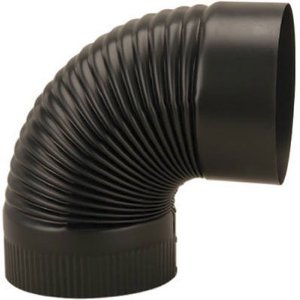Whether you have a wood or gas stove or an existing chimney, you will become intimately familiar with your flue. This tall chimney-like section above your fire is responsible for the draft that carries gases and smoke out of your home and pulls fresh air inside the firebox. The flue's ability to draw is what creates a strong and healthy fire. At the same time, it protects your home from fire danger.
This article looks at what a connector pipe is, how it works, and how to clean and maintain your pipe.
What is a Connector Pipe
A connector pipe, or stovepipe, is a single wall or double wall pipe that runs vertically from your stove to a masonry chimney or Class A chimney. The connector pipe is the only visible portion inside your home. It does not feed inside walls, ceilings, or attics, or outside your home.
Why only inside the room? It doesn’t insulate as well as a Class A chimney pipe. Wood stoves can reach temperatures up to 2,100 degrees F, and a Class A chimney pipe can take the heat, but a connector pipe would become so hot that it catches surrounding items on fire. Still, heat radiation is what you want inside the home, which is why a connector pipe sits inside the room.
Benefits of a Connector Pipe
In addition to funneling gas and particles from the fire out of the room, the pipe allows for more efficient burning by keeping more of the fire and heat inside the stove than a standard chimney can. It is also easier and cleaner to maintain than a typical chimney. The parts are inexpensive, and you can do the work more easily and affordably than repairing a fireplace.
What Types of Units Use a Connector Pipe?
Wood stoves all use connector pipes. Gas stoves usually don’t.
Types of Connector Pipes
Connector pipes come as single-wall or double-wall connector pipes:
Single-wall connector pipes are one-walled section of piping. They have the least heat retention and are often used to radiate maximum heat into a room. for solid fuel, they must be 24ga minimum. 22ga is thicker so is often used. Single wall has an 18" clearance to combustibles.
Double-wall connector pipes have a second layer of pipe inside and a gap between each insulated section. The air insulation can provide heat retention up to 2,100 degrees, but the pipe is not a Class A pipe. With it you can position your flue closer to the interior walls without risk of fire damage. A double wall only needs 6" clearance.
Both single and double wall pipes look the same from the outside, and they assemble the same.
Issues to Be Aware of With a Connector Pipe
Connector pipes are not without problems. One of the most common issues is blockage of creosote and soot, at which point the pipe will need to be cleaned or replaced.
Additionally, single-wall connector pipes can be extremely hot to the touch.
Never use galvanized single wall pipe with wood or coal stoves.
How to Install and Replace a Connector Pipe
Connector pipes are easy to assemble. Some versions twist together, while others are crimped or fastened together with self-tapping screws.
The pipes often have a female side (typically facing upward) and one male side (facing downward). The male sides feed into the female sections, allowing creosote and other liquids drip safely into the firebox instead of leaking outside.
To install, follow the instructions provided by the piping or start by moving from the stove upward, ensuring the female sides remain up or feed horizontally out of a room.
How to Clean a Connector Pipe
Cleaning should be done often. Look for any blockages, such as from debris, and keep an eye out for soot and creosote ¼’ thick or more inside the pipe. When it is time to clean:
- Use a wire brush designed for connector pipes to scrape off the creosote and debris.
- Continue with a more thorough cleaning using a vacuum with a long attachment.
- For more stubborn creosote, use soap and water to clean the pipe’s interior or burn creosote-busting logs and powders that will penetrate into the creosote and loosen it up. For more details on products for cleaning out creosote, click here.
How to Maintain a Connector Pipe
The two main issues to spot in your connector pipe are obstruction and damage. Critters, bird nests, and creosote buildup can be taken care of with regular cleaning. As for damage, a poorly installed pipe can experience issues of leaks of smoke or creosote liquid, and the heat in the pipe can cause the piping to even crack over time. You may need to realign or replace the piping.
Do monthly inspections to look for these issues and creosote buildup, and be sure to fix them immediately. They affect your stove's efficiency and overall heat performance and lead to fire dangers and breathing issues - even carbon monoxide poisoning.
Connector Pipes: Connecting You to More Efficient Warmth
When the time comes to purchase or replace your stove piping, you stand to save significantly with connector pipes vs. using a traditional chimney while boosting your fire’s efficiency, saving you even more. With regular cleaning and maintenance, you can the most for your investment.


/1003/site-assets/logo.png)


